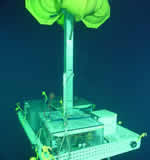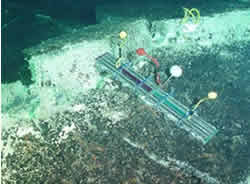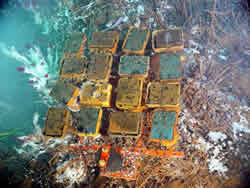|

| |

The ROPOS elevator on its way back up to the
surface filled with experiments that have been in place for one year
or longer. |
Teacher's Report
Bill Hanshumaker, Educator at Sea
ROPOS was re-deployed yesterday at 2022
pm Pacific Standard Time (PST), for its second dive of this year's NeMO
expedition. However, the video logs that I've been asked to keep are in
Universal Time Coordinates (UTC). This is equivalent to Greenwich Mean
Time (GMT), which is 7 hours ahead of PST, so I needed to record ROPOS's
deployment as 0322 on August 31st. As you may imagine, it is sometimes
a challenge to keep the time recording consistent.
Before its deployment, an elevator was
attached to the bottom of the ROPOS cage. An elevator is a structure that
can be detached from the cage once ROPOS reaches the ocean bottom, or
deployed over the side independent of ROPOS. It is used to deploy or retrieve
experiments and samples to or from the seafloor. The elevator allows more
experiments to bedeployed and recovered during a single dive, as it has
a larger holding-capacity than ROPOS.

The gastropod
"racetrack" deployed at Marker 33 vent. The far end of the
experiment is in high flow, the near end is away from the flow. The
goal is to determine which factors contribute to gastropod distribution
around vents. |
|
Our elevator consists of a frame with eight
yellow flotation devices attached to its top. It is capable of lifting
at least 600 pounds, but additional floats can be added to achieve more
lift. On this dive, biologists put two types of experiments in the elevator,
one going down and one coming back up.
One is affectionately called the "racetrack"
and it will be used to determine if vent fluid flow controls the distribution
of vent gastropods. Two species are found around high flow vents and one
is found around the low flow vents. This device eliminates other biological
factors (such as food or competition), and will help determine if gastropod
distributions are controlled by vent flow.
| |

These arrays were recovered after a one year
experiment to measure larval recruitment and subsequent survival of
developing juvenile vent animals. These arrays were placed next to
a high-flow area at Cloud vent. Other arrays were place on the periphery
of the vent to compare larval recruitment in high and low flow areas.
. |
Larval settling arrays experiments were
recovered. Marine invertebrates go through a larval stage during which
dispersal occurs. Settling arrays are used to measure recruitment success
and subsequent survival of the developing juveniles. Also, during last
year's NeMO expedition sections
of different kinds of wood were left on the bottom to record the same
process (what kinds of larval animals would colonize on the wood). We
plan to recover the wood on a future dive, but were not equipped to do
so on R736. Close observation revealed what appeared to be hundreds of
siphons waving like hair in the breeze, possibly from wood-boring clams,
now living in the wood.
This was a much shorter dive than our first
one and ROPOS and the elevator were both recovered by 10 o'clock this
morning. The third ROPOS dive is scheduled for 1600 hours PST. At present
a Conductivity Temperature Depth (CTD) device is taking place to search
for evidence of hydrothermal plumes in the water column above the caldera.
.
|

